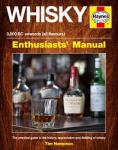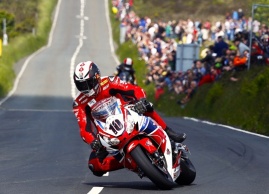Ten of the best for a tasting in Russia
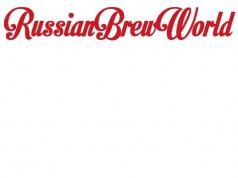 There are my 10 beers/brewers for a tasting at the BrewWorld conference in St Petersburg, Russia next week.
There are my 10 beers/brewers for a tasting at the BrewWorld conference in St Petersburg, Russia next week.
- Brew Dog Punk IPA
- Chimay Blue
- Duvel
- Mikkeller
- Rodenbah Grand Cru
- Anderson Valley Bourbon Barrel
- Fullers Past Masters 1910 Double Drop Stout
- Jopen Jacobus Rye Pale Ale
- Orval
- Hook Norton Twelve Days
A dalliance with wine – the Haynes Wine Manual
 Wine has a cultured history which flows like a stream of consciousness from our pre-historic beginnings to the current day. And it is a little bit of this story that I try and tell in the Haynes Wine Manual.
Wine has a cultured history which flows like a stream of consciousness from our pre-historic beginnings to the current day. And it is a little bit of this story that I try and tell in the Haynes Wine Manual.
It is the first time I have written about wine – books on beer and whisky were my drinks of choice. And I have to admit that I’ve been on quite a journey as I’ve discovered much about the history of wine and its close links with our culture.
I’ve explored wine in all its colours and styles and found out what a marvellous companion it is not just to food but as an ingredient in its own right and its quite easy to make at home.
Almost, since the first sip of wine was taken it has inspired philosophers, painters, poets, potters and even politicians. It is a drink of great complexity, which can soar with rich flavours and wonderful aromas. Wine is the drink for Kings and Queens and it flows like a river through many of our religions. But, wine is also the drink of ordinary people, an easy going drink often made from fruits foraged the field.
The Egyptians, Greeks and Romans took grape vines with them wherever they went – wherever their cultures touched can be founded traces of winemaking and its consumption.
And so too, when Europeans set off in frail ships to explore the earth and landed in Australia and South and North American, they carried vines. Wine clearly was seen as part of a civilising and civilised life.
It is a drink now made on most continents and in many counties. But, good wine doesn’t just come from faraway places, it can be found here in England too.
Not far from Oxford, there’s the Bothy Winery in Frilford Heath. Here it’s quite clear to see the link between the earth, the rhythms of the seasons and the wine made. Here they link wine with art, as once a year they put some really nice sculptures within their vineyard itself. It’s a fabulous display.
In researching the wine book, I was often asked what is the best wine in the world? What is the best wine you have ever drunk?
I’ve been lucky and visited some of the finest winemakers in the world and sipped on some of the world’s most expensive grand cru wines destined to be drunk at a fine banquet or dinner.
I’ve also drunk fresh wine, straight from the barrel, which the maker is proud to call “vin ordinaire” and say “this is not for storing, it is for drinking.”
Great wines are all about the moment, the company and the conversation.
Recently on a trip to France, I was in the company of one of France’s new wave of innovative winemakers Domaine Bellevue’s Jean-Francois Boras, we decided that we should find a cafe to eat in.
It was a Monday night, in Cadillac, set in the heart of one of the country’s great wine growing areas, Bordeaux. However, we only found one café open – an Italian pizzeria. A style of café surprisingly common in south west France.
So as we snacked on slices of freshly made pizza, Jean-Francois ordered a bottle wine.
Outside the heat of the day, still filled the air, it must have been nearly 30C and as the sun set and church bells tolled, the day seemed to get no cooler.
In the region of France, which produces some of the greatest wines ever made, Jean-Francois ordered a bottle of Italian 8% red Lambrusco. He also asked for some ice cubes.
And so we sat, sipping on our glasses of wine, into which we’d put some of the ice cubes. For that moment, it was the perfect wine. Light and refreshing, it lifted our spirits, took some of the heat out of the day and inspired our conversation.
And as the sky went dark and we could clearly see the planets Venus and Jupiter basking in the sun’s excess in a celestial embrace. I realised, for that moment, I had the perfect wine.
“Wine” says Jean-Francois, “enables us to discover who we are.”
The Haynes Wine Manual cannot replicated the tastes and textures of a glass of wine, it cannot repeat the sheer, pleasure of drinking a glass of wine and it cannot explore every nuance and fact about the thousands of vineyards and winemakers worldwide.
But, the book might just help people find their own perfect moment.
Haynes Wine Enthusiasts’ Manual is priced at £22.99 and available from http://www.haynes.co.uk
The Cat’s Back – A welcome London survior
Can there be a better street corner pub? There is something endearingly attractive about this pub. Even its name is eccentric. Built in 1865, it was called Ye Olde House and Home, and provided a place where lightermen from the Thames and Wandle could drink pints of liquid 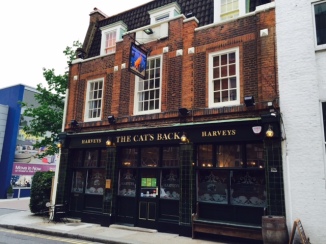 bread. But at some time the landlord’s moggy went walkabout – and after a month’s absence it returned – and the rest they say is history.
bread. But at some time the landlord’s moggy went walkabout – and after a month’s absence it returned – and the rest they say is history.
The pub is a survivor, standing shoulder to shoulder with row upon row of luxury apartments. It was bought by Sussex brewer Harveys in 2012. This backstreet boozer is a hidden gem amidst the high rises of Wandsworth. Recently refurbished the bright and airy, front bar is cosy and comfortable with a bohemian community atmosphere, which is in keeping to the pub’s local, communal and traditional roots.
It is a Victorian survivor which now nestles in the new riverside quarter between Wandsworth and Putney in South West London. The pub recently won Joint first Place for the Campaign for Real Ale’s Joe Goodwin Award for the Best Corner Street Local National Pub Design. Upstairs allows for more space and privacy away from the front bar area with a dual use function room.
A small, decked beer garden is out the back and it is only a five-minute walk from the ever moving Thames.
The food is wholeheartedly pubby, rather than foodie, but that doesn’t stop it being it being memorable. Home-made pies and tarts, hearty sandwiches, seasonal soups, daily specials, traditional desserts and Sunday roasts are the order of the day. And for anyone who likes ale, what could be better than a glass of Harveys Sussex Bitter. Full bodied and golden brown, its aroma of swirling Goldings hops is in near perfect balance of with the barley malt in the beer.
The pub will feature in a new edition of London’s Riverside pubs which publishes next year.
86-88 Point Pleasant, SW18 1NN
Article from the OC HC
Go to http://oxhc.co.uk/Straight-talking-wine-Jack-Rayner-talks-to-Tim-Hampson.asp to see the article in full
Straight-talking wine: Jack Rayner talks to Tim Hampson
“I’m trying to show that wine is fun, or should be fun”
The world of wine is often difficult to wrap your head around, and experts in the field are rarely as friendly or straight-talking as Tim Hampson
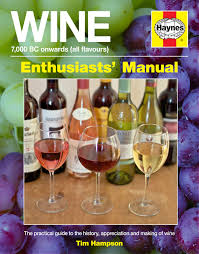
When we learnt that he’d published a “down-to-earth” Wine Manual, we thought it was only right that Jack Rayner spoke to Tim about the confusing world of wine, as well as Oxfordian breweries and his attitude to buying the right bottle.
How does a man come to accumulate such vast knowledge of alcohol?
It takes a lot of sitting in bars.
Sounds like a hard life.
Yes, it does mean that I’ve spent a long time travelling around, going to wineries, distilleries and breweries, but the thing that links them all is that these drinks have social and economic history in most areas, and also the fact that they are usually run by really wonderful, creative people who like nothing more than to talk about what they do.
Right. So in terms of where you’ve travelled, is there a particular place that exemplifies that attitude?
To be honest, if we can talk locally, these jewels exist everywhere. In terms of wine, there’s the Bothy Winery which is not far outside Oxford. When you go there, it’s quite clear to see the link between the earth, the rhythms of the seasons and the wine they make. As importantly, and this is something that features in my book, they link wine with creativity very much. They put some really nice sculptures actually within their vineyard itself once a year and I’m not sure if the artists are influenced by wine itself, but it’s something that’s really interesting to see.
I’m more of a beer drinker myself, and I know about the differences in process in how you can use different malts, hops and techniques to create different flavours, but I’m not so knowledgeable about wine. Is there similar scope for creating different flavours whilst using a single variety of grape?
I could argue that making beer is more difficult, because there are more raw materials involved. Beer-making is a continuous process. Most brewers are making beer throughout the year, whereas with wine, you have a harvest and you squash the grapes. There are certainly different skills needed within wine making: You need the skill of the people in the vineyards who know how to grow and prune the grapes so that you achieve the maximum growth for the type of grape you’re looking for. Then, there is a skill which you don’t see as much in beer brewing, which is the ability to blend wines of different grapes. If you’re using more than one grape variety, you’re looking to marry them together to make the one wine. At that point, the person who is assembling the wine does need a lot of skill.
Is it a similar idea to blending whiskies?
I guess so, yes. That’s a fair thing to say.
Moving towards the study of the drink, tasting wine is considered a much more high-brow pastime than with beer, but is it a similar discipline?
Well yes, whatever you’re judging, whether it’s porridge, cheese, wine or beer, you look at it, you sniff it, and you taste it. What I certainly try to do in the wine book is to avoid mystifying wine tasting, which I think is something that often happens. You can go to parts of Spain or France and wine is the same as we regard beer or lager in this country: it’s the working person’s drink. You make it in your farm or in your kitchen, and you drink it. You either like it or you don’t, and it’s as simple as that. I do think we can over-mystify wine.
Certainly. You touched earlier on the more local vineyards and wineries. Did you grow up in Oxford?
No, I didn’t, but I’ve lived in Oxford for about 25 years.
Well as Oxford is renowned for its pubs, has the city influenced your career?
Well, we were talking about brewers earlier, and in Oxford I think we probably have around 30 brewers now. In this county we have one of the oldest craft brewers in the country at Hook Norton, who are a fantastic example of how an old-style brewery can convert to a modern craft brewer.
Absolutely. I was at Hook Norton not 2 weeks ago, and their operation is astounding.
Isn’t it? They’re constantly looking at their beers and adapting their beers… To progress, you have to understand your past, I think. They are continuing to progress and develop new beers which are classics of this age, rather than replicates of beers from another age.
What are your thoughts on the microbrewery and craft beer scene? Do you welcome the surge in producers?
I think it’s absolutely brilliant. Whether it can continue or not, we’ll have to wait and see. Probably within a 30 or 40 mile radius of Oxford there might be 60 or 70 breweries, and it’s still growing. Whether we can continue with that rate of growth, I don’t know. Another fantastic example is Shotover Brewery, another local brewer who are exemplars of modern brewing style married with absolute top quality. They have a different business model from others, which I think is to only sell within 15 miles of the brewery. You’ve got quality, you’ve got class, and it’s something which is really very local.
Going back to your wine manual, what should we look out for in the book that might not be included in other wine-based books?
What I’ve tried to do is – people often ask – probably two things – one: the best wine probably isn’t the most expensive one you see on the shelf, but it’s to do with the company you’re with, the location you’re in, the conversation that’s going on, and the interaction between you and the people you’re sharing the bottle with. If that’s the cheapest bottle of wine you’ve just gone out and bought from your local supermarket, and you’re enjoying it for what it’s meant to be: a drink that encourages conversation and encourages thinking, then that’s the best bottle of wine in the world.
What a great attitude.
If someone says “Oh I never buy a £10 bottle of wine, I only buy £30 bottles of wine”, I just think “why?”. With a little bit of extra knowledge, or different knowledge, you might realise that something has a rarity to it, and perhaps that’s worth trying because there isn’t much of it available. What I haven’t tried to do in the book is give endless lists of grand cru estates from France, which you find in many wine books. I’m trying to show that wine is fun, or should be fun.
That’s definitely a welcome attitude. What are your plans for the future?
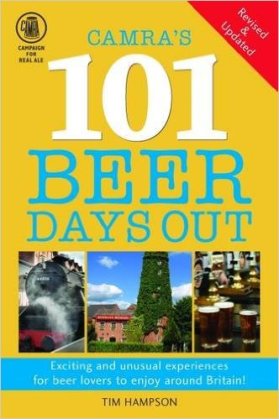
I’ve just finished another book, London’s Riverside Pubs, that’s due out next year. I’ve also just had another book published almost at the same time as the wine book, which is 101 Beer Days Out, which is a collection of beer adventures that people can have over different parts of the country. Some are brewery tours, some are train trips, some are big carnivals…
You must have a great time putting these books together.
Haha! Well it’s like any other bit of research, isn’t it? I have to do the same graft as any person involved in the media, and I have to stay sober enough to remember what I’ve done! It doesn’t always happen but I try to.
Wine: 7,000BC onwards (all flavours) Enthusiasts’ Manual is out now, published by Haynes.
Tim’s Hampson is hosting a beer tasting at 7pm on 11 December, at Blackwell’s, 48-51 Broad Street, Oxford. To make sure you get a place, buy tickets in advance from the customer service desk in the Norrington Room or by calling 01865 333623.
Talking local at Blackwell’s book shop
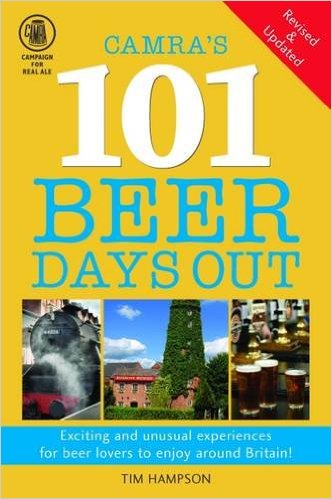
I’ll be talking local when I host a beer tasting event at Blackwell’s book shop in Oxford on 11 December at 7pm, drawing the bookshop’s food and drink festival to a close.
I’ll also be talking about my book 101 Beer Days Out, recently updated and republished by the Campaign for Real Ale.
101 Beer Days Out celebrates many Oxfordshire pubs and breweries, including the historic Hook Norton brewery (and nearby Pear Tree pub), the fabulous views from the Castle Inn in Edgehill, and the wealth of pub offerings Oxford itself boasts – from the Bear, to the Eagle to the Lamb & Flag to the Turf Tavern.
The tasting starts at 7pm, Blackwell’s, 48-51 Broad Street, Oxford. To make sure you get a place, buy tickets in advance from the customer service desk in the Norrington Room or by calling 01865 333623.
Blackwells events page: http://bookshop.blackwell.co.uk/stores/events/
Buy the book at the CAMRA shop: https://shop.camra.org.uk/books/101-beer-days-out-194.html
101 Beer Days Out ISBN 9781852493288, RRP £12.99, published by CAMRA Books.
Brewery trust saves thousands of at risk pub photos
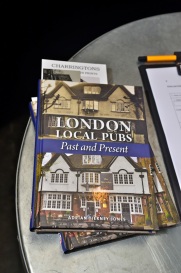 I am immensely proud to have played a small part in the completion of the first major project by the National Brewery Heritage Trust (NBHT), of which I am trustee.
I am immensely proud to have played a small part in the completion of the first major project by the National Brewery Heritage Trust (NBHT), of which I am trustee.
London Local Pubs: Past and Present is a new book written by Adrian Tierney-Jones, which contains many historic, once at risk, photos of 52 pub, in the London area, which has just been published.
It includes a selection of some of the finest pictures from a stunning collection, not seen for more than a quarter of a century, some dating back to the 1900s which has now been digitised and put online.
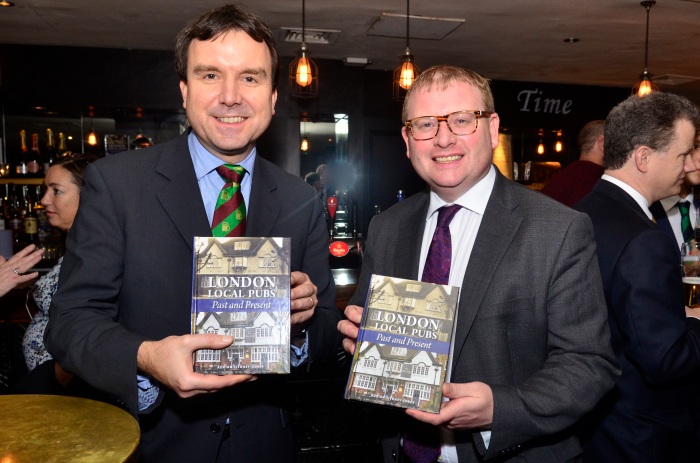 The book was launched last week in London at the Magpie and Stump pub, in the presence Burton MP Andrew Griffiths and community pubs minister Marcus Jones (pictured above).
The book was launched last week in London at the Magpie and Stump pub, in the presence Burton MP Andrew Griffiths and community pubs minister Marcus Jones (pictured above).
And it could all have been so different, as in the late 1980s, the entire collection was only moments away from destruction.
The collection’s saving started when NBHT trustee Robert Humphreys, who then worked for Charrington’s brewery in East London, rescued the photographs, which had been thrown into a skip.
Humphreys arranged for the photos to be donated and sent to the Bass Museum in Burton (Now the National Brewery Centre), where the pictures were safely stored.
In 2014, the National Brewery Heritage Trust (NBHT) http://www.nationalbreweryheritagetrust.co.uk/working with Historypin http://www.historypin.org and Heritage Assets began the project to digitise the historic photos with the intention of making the collection available to online researchers and to anyone who wanted to commercially use the images.
The on-line collection includes more than 3,500 images, dating from the Edwardian period to the 1970s, which depict more than 1,250 pubs from the now long gone Charrington. While many of these pubs survive and prosper under a range of new owners, others have been lost to WWII bombing or redevelopment.
Now, some of best photos from the collection have been included in London Local Pubs: Past and Present published by Halsgrove. Publishing.
London Local Pubs: Past and Present juxtaposes the historic pictures with contemporary shots taken from precisely the same spots as the originals, enabling a fascinating comparison of the changing times through which the buildings have survived. All the pubs featured in the book are still open.
To find out more about London Local Pubs and to get your own copy, visit www.londonlocalpubs.com
Go to http://www.nationalbreweryheritagetrust.co.uk to find out about the NBHT.
WHISKY – AN ENTHUSIAST’S MANUAL
This review is taken from the London Drinker magazine- and with thanks to Brian Sheridan for writing it. But I guess I’ll never make him a fan of Tom Jones or a Bobby Burns Cocktail.
The name of Tim Hampson will be familiar to many as a prolific and award winning writer on beer. In this book, however, he turns his attention to the world of whisky. His book ‘Whisky’ is described as an ‘Enthusiast’s Manual’ and forms part of the series of ‘manuals’ produced by Haynes Publishing.
The book is a wide ranging compendium of information about the spirit which is such a close relative of beer. Topics range from the early history of distilling (possibly going back to the third millennium BCE) to present day developments.
While, inevitably, Scotland and Ireland are given pride of place, the book describes how whisky has become a world drink with production taking place in six continents. There is an informative chapter on the production of whisky – from the malting of barley or other grains, mashing and fermentation to the final stages where fermented liquor (‘wash’) is distilled into spirit. Everything is accompanied by photo-graphs produced to a high standard.
An interesting section is that on recent developments in the industry. There is in effect a ‘craft’ movement which is pushing the boundaries of ingredients, particularly the use of hops. In effect, they are now distilling beer. I have not encountered any of these products yet but the prospect of a distillation made from Duvel, Gouden Carolus or Adnams Broadside is, to say the least, intriguing. The purist may well question whether these products should be called whisky and it may be significant that neither Duvel nor Adnams describe their distillations of beer as ‘whisky’. (Adnams also make two unhopped spirits, a single malt and a mixed grain spirit, both of which they do, perfectly reasonably, call whisky.)
Not having sampled any of these products either, I cannot comment on whether these new developments are real progress or gimmickry but I do wonder just how much of the highly volatile aromatics in hops makes it through to the final spirit and what proportion is discarded in the first running of the still (foreshots) which contains the nasties such as higher alcohols and other congeners.
Inevitably in this day and age, there have to be sections on various accompaniments to whisky. The handful of recipes using whisky (inevitably including that Scottish classic dessert cranachan) sound intriguing and I certainly hope to try them. Whisky cocktails sound a bit doubtful however: mixing whisky with Angostura bitters, Benedictine and red vermouth sounds vile and a waste of the good Speyside malt recommended in the recipe.
Matching food is fair enough but trying to match music to whisky seems a questionable idea. Yet here we have the Speyside distillers Glenlivet suggesting the Average White Band and Alabama Shakes as music to go with their 12 year old malt and Jimi Hendrix as an accompaniment to their 18 year old version. It gets worse: the author himself suggests a Tom Jones song to go with an Islay malt and the offerings of Madonna as something to listen to while drinking a Speyside malt. I half expect certain beer writers to pick up on this idea, so look out for some real absurdities in future!
We can also expect Mr Hampson’s idea of matching beer with chocolate to be taken up by the beer writing fraternity: fair enough – a few squares of Cadbury’s Dairy Milk is a good way of taking away the nasty taste of so many microbrewery brews. Occasional silliness aside, this is a book which should interest and inform anyone partial to a dram or two. As a lover and drinker of whisky I certainly learnt a lot, and had one or two misconceptions cleared up.
A thoroughly enjoyable read. Whisky – Enthusiasts’ Manual, Haynes Publishing, Sparkford, Yeovil. Email sales@haynes.co.uk or website http://www.haynes.co.uk. 168pp Recommended Retail Price £22.99
Biker bliss and beer at the greatest road race in the world
This is my take on the Isle of Man bike races, which are currently happening. It first appeared in 101 Beer Days Out, which was published by CAMRA. The book is currently being updated.
They must be mad. There is a harsh, precarious beauty to the screaming sound of a 999ccc Honda, throttle full open, hurtling down winding, twisting, rising, falling country roads, at speeds well in excess of 140mph. Astonishingly, the Isle of Man races take place on public roads, complete with drain covers, manhole covers, bumps, lumps and uneven surfaces.
 The moment between the quick and the dead seems infinitesimal as riders flash by, with seemingly only occasional hay bales protecting them from the oblivion of hitting an unremitting stone wall.
The moment between the quick and the dead seems infinitesimal as riders flash by, with seemingly only occasional hay bales protecting them from the oblivion of hitting an unremitting stone wall.
The Isle of Man mountain circuit is without doubt the greatest challenge any racing motorcyclist can take on. Each year more than 500 riders arrive on the island in June for the TT races in June or the Manx Grand Prix races in later August and September.
It is a dangerous circuit 37.37 miles round, which astonishing the top riders can lap in 17min at an average speed in excess of 130mph.
The riders are the stuff of legend Geof Duke, John Surtees, Barry Sheene and Mike Hailwood have all raced here. Today’s heroes are multiple-winners Joey Dunlop and John McGuinness, names adored by their fans.
Motor racing first came to the Isle of Man in 1904 when the Gordon Bennett car trials were held, bikes first raced here a year later and they are still doing it.
The Mountain circuit begins on the front in Douglas and heads at a break neck pace west to via Ballaugh, Sulby to Ramsey some 23 miles away. Here the riders straining every sinew and rivet start the daunting mountain climb from sea level, rising some 1400 ft to the highest point at Brandywell
From here is almost down hill all the way down to Creg-ny-Baa and the return to Douglas. The circuit has been completed faster than most people can drink a pint.
Each evening the racing is on the road along the seafront in Douglas is closed for bike displays. Rolling burnouts leave black rubber marks across the road and over the tram tracks and the air fills with the sound of screaming, howling engines and the sweet smell of burning oil. It’s biker heaven. And then there is mad Sunday, when for a couple of hours the course is open for the public to ride bikes around at unrestricted speeds.
The Isle of Man is a beautiful and unspoilt place with a rich history and worth visiting even if the bikes are not racing. It has many gentle walks, horse drawn trams, some fine pubs, and four breweries – Bushy’s, Hooded Ram, Okells and Old Laxey.
Some pubs which offer a view of the TT
Crosby Hotel
Main Road, Crosby, IM4 2DQ
Creg-ny-baa
Mountain Road, Onchan, IM4 5BP
Ginger Hall
Main Road, Sulby, IM7 2HB
Quarterbridge Hotel
Quarterbridge, Douglas, Isle of Man, IM2 1HB
Railway Inn
Main Road, Union Mills IM4 4NE
Raven Bar
Ballaugh Bridge, Ballaugh,
Sulby Glen Hotel
Main Road, Sulby, IM7 2HR Ramsey
Isle of Man RR race information
Isle of Man information
It’s all about the people – A History of the International Brewing Awards
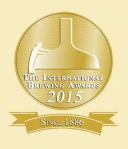 Good writing and journalism is about telling other people’s stories well.
Good writing and journalism is about telling other people’s stories well.
The best commentators are able to take, what at first sight might be a dull subject and make it compelling reading.
The story of the International brewing Awards (IBA) is not one which immediately captures the imagination, after all it can be little more than a long, list of different beers?
In this book, Brewing Champions – A History of the International Brewing Awards, Adrian Tierney-Jones tells a story which amazes and galvanises.
The narrative is underpinned by not just a love of beer but the importance of robust historical analysis often from primary sources.
And above all it tells the story of the ardent and dedicated people who are proud to call themselves brewers.
 The International Brewing awards is the longest established brewing competition in the world. First held in 1888 at the Agricultural Hall, Islington on north London.
The International Brewing awards is the longest established brewing competition in the world. First held in 1888 at the Agricultural Hall, Islington on north London.
Across three centuries the awards provide an annual snapshot into the world of beer – and an insight into how the once conservative and narrow spectre of British brewing has grown to embrace a multitude of styles, ingredients and continents.
But, it is the brewers themselves who are the stars of this book – it is their triumphs and disasters, rivalries and friendships which turn what could be just be a stodgy list of beers into an illuminating, insight into our world.
As the current chairman of the IBA Bill Taylor says “Adrian in one book has created a history book, a story book and a reference book.
“I feel that this book should be seen as the beginning of something and it is a work that begs to be continued in the future.”
 Brewing Champions – A History of the International Brewing Awards, Adrian Tierney-Jones.
Brewing Champions – A History of the International Brewing Awards, Adrian Tierney-Jones.
Published by the by the BFBi and for details on how to buy itplease email info@bfbi.org.uk.
Pinning our hopes on a digital history
Thousands of historic pub photographs are being digitalised by the National Brewery Heritage Trust (NBHT), as part of a move to preserve the country’s pub heritage.
And it could all have been so different, as in the late 1980s, the entire collection was only moments away from destruction.
The collection’s saving started, almost by chance when the phone rang in the office of former All Party Parliamentary Beer Club secretary Robert Humphreys, who was at the time working for Charrington’s in London.
Humphreys, who is now a trustee of the NBHT, said: “25 years ago I received a call from a colleague alerting me to the casual disposal of the entire, priceless collection of some 5,000 pub photographs, some dating back to Edwardian times.
“There in a skip in the yard at the old Charrington brewery in the Mile End road was the filing cabinet, stuffed to bursting with these images.
“Thankfully I managed to retrieve it and arrange for it to be delivered to the Bass Museum in Burton (Now the National Brewery Centre), where the pictures have safely survived for the intervening years.”
The NHBT was formed was formed to support the work of the museum with funding from CAMRA and the Burton Civic Society, and last year, it together with the Save Photo and Historypin agreed to digitise the entire collection.
 “Now, at last, the collection is to be made available on-line to all of us, thanks to the combined efforts of those involved. I could not be more delighted,” said Humphreys.
“Now, at last, the collection is to be made available on-line to all of us, thanks to the combined efforts of those involved. I could not be more delighted,” said Humphreys.
Historypin is working with the Europeana project is to develop a book and ebook based on the collection and on additional material sourced from the pubs themselves, pub regulars, the National Brewery Heritage Trust and other organisations.
To collect this material, Historypin will organise events in selected pubs that invite landlords and regulars to come and admire the Charrington collection photographs, as well as ask them to contribute their own memories, photographs and stories.
In the meantime, a few pubs have expressed their interest in having a high-resolution image from the Charrington collection on their wall.
http://www.historypin.org/ http://nationalbreweryheritagetrust.co.uk/
Tim Hampson’s Tweets can be found @beerhero
His published work includes The Beer Book, World Beer, Haynes Beer Manual, Haynes Whisky Manual, Eyewitness Companion Beer, Great Beers, 101 Beer Days Out, London’s Riverside Pubs, London’s Best Pubs, London’s Best Style Bars, Room at the Inn.
He was also a contributor The Oxford Companion to Beer and 1001 Beers You Must Try Before You Die.
He is currently chairman of the British Guild of Beer Writers.
